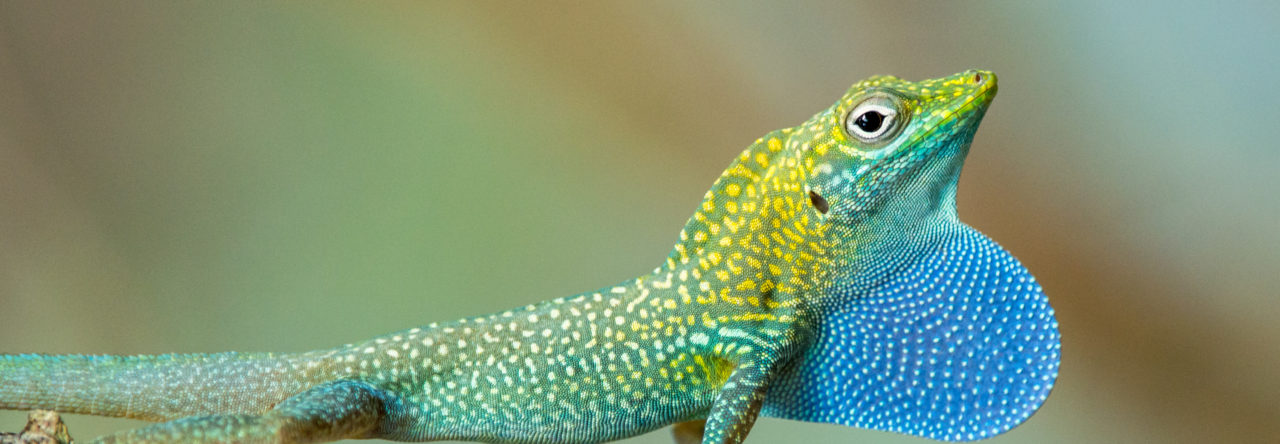One day, years ago, I was collecting data on the behavior of the Jamaican twig anole, A. valencienni. As I was watching a female, to my surprise, she entered a hole in a tree trunk, and then emerged a little while later. To my amazement, I then saw another valencienni do the same thing! Overcome with curiosity, I approached the tree, peered into the hole, and spied to my astonishment a large number of what seemed to be anole eggs. I was not aware that communal nesting—in which multiple females lay their eggs in the same place—is known in a number of anole species, including A. angusticeps, A. bartschi, A. lucius and A. valencienni. The seminal work on the subject is still Rand’s 1967 Herpetologica paper.
A recent paper adds another species to the list of known communal nesters, the first from Central America of which I’m aware.
Montgomery et al. located seven nests containing 47 eggshells and 67 unhatched eggs on the side of large moss- and vegetation-covered boulders along the side of a stream in Panama. Hatching the eggs in the laboratory confirmed that they belonged to A. lionotus, one of the Central American “aquatic” anoles always found immediately adjacent to streams.
Why anoles nest communally is unclear, though the best guess is probably that good sites are limited, combined with the fact that females, which can lay a single egg every 1-2 weeks, may return to the same place repeatedly (though this has not, as far as I’m aware, been documented).
Actually, surprisingly little is known about all aspects of anole nesting and egg biology.
- Evolution in Real Time on Lizard Island - March 23, 2025
- Spider Snags Adult Anolis osa - March 22, 2025
- An Homage to the Green Anoles of New Orleans - March 21, 2025




Dave Steinberg
In 2007 I was fooling around with A. oxlophus (another Central American semi-aquatic anole) in the San Luis Valley, Costa Rica. I found a number of eggs (on the side or under rocks) and most seemed to be all alone. In one instance, there were several eggs on the underside of a large boulder (some hatched, some unhatched; I didn’t count them). Of course, this is nothing compared to the 7 ‘nests’ found by Montgomery et al., I figured I’d put the information out there in case anyone else wants to take a day to explore the creek and river-beds of CR. It would be interesting to know how many species ‘communally nest’ and whether there are any general patterns. All the anoles listed above are twig anoles or species that utilize rocky areas, right? Maybe its just easier too find eggs in these habitats, or maybe it’s something else.
Scantlebury
I’ve seen piles (=dozens) of hatched and still cooking anole eggs in dozens of rotting Agave plants in the xeric scrub of the low lying foothills of the Sierra Martin Garcia of the DR. Presumably, they were from Anolis brevirostris (the most abundant anole in the area, but A. singularis and A. whitemani are found in sympatry at this site). The interior of these dead Agave retain a fair bit of moisture, and the decaying tissues are spongy and soft. This is a much more anole-friendly incubation medium than the dry, hard-packed soil of the surrounding landscape. The Agave also harbor a number of Sphaerodactylus species, and, of course, piles and piles of their eggs, too.
I’ve also found a couple handfuls of what had to be hatched Anolis baleatus eggs underneath large karst rocks in the Haitises region of the DR. These rocks typically had 3-5 egg shells underneath them, in a loamy mix of decomposed karst pebbles, leaf litter, and dirt.
Of course, most anole biologists aren’t looking in semifossorial habitats for anoles, so this sort of data is easy to miss.
Another peculiar observation I heard about (but wasn’t around to see) took place last summer on Union Island in the Grenadines. Students at Bob Powell’s REU witnessed multiple female A. aeneus descend from scrubby trees to lay eggs in loamy soil in the afternoon! I know there’s a video floating around somewhere. If I recall correctly, they did this during a period of the day when the Amevias were no longer active.
Sean Doody
have you seen my 2009 review in communal nesting in reptiles and amphibians in QRB? Sean Doody